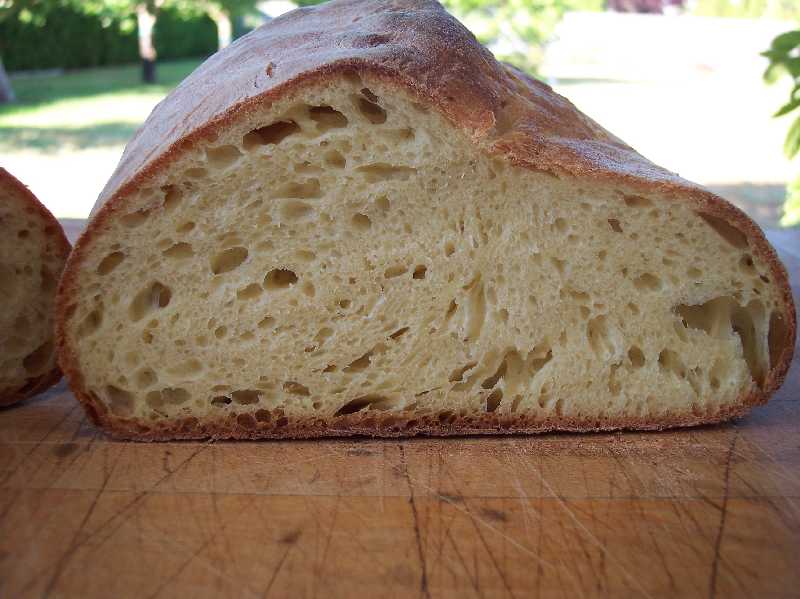
Since posting my last effort at making the Pane Tipo Altamura http://www.thefreshloaf.com/node/24102/pane-di-altamuramy-ongoing-project it's been an unexpected pleasure to have received so much interest and support for this project from so many TFL members. Thanks to everyone who's responded with new information, tips and suggestions, videos, etc, but especially to David Snyder for taking enough interest in the project to do his own bake of the bread. http://www.thefreshloaf.com/node/24139/pane-tipo-di-altamura-quotlocal-breadsquot
It's always a bonus when you have David's insight and scrupulously well taken notes to refer to. I found them very instructive before beginning this latest bake. Thanks David!
Although I strayed slightly from some of the criteria outlined in the Altamura DOP document, http://eur-lex.europa.eu/LexUriServ/LexUriServ.do?uri=OJ:L:2003:181:0012:0019:EN:PDF I feel I could have stayed within the criteria and produced a bread of similar quality and attributes as this latest effort. Something I'll endeavor for future bakes now that I have a much better understanding of the process.
The most significant difference between the DOP regs and what this mix included is the percentage of preferment. The DOP calls for 20% of preferment and I used 24.25%. Overall hydration (not counting that of the starter) was slightly higher than 60% regulation at 62% . Other than that it stayed reasonably close to what was outlined in the DOP.
The differences between this dough and the last one were like night and day in terms of the texture and fermentation. The preferment was considerably stronger, and why I'm sure that had I used only 20% instead of the 24%, I would have achieved very similar results. The lower hydration of this dough also made a world of difference to the crust and crumb.The crust is crackly, with a good chew to it, and a rich, toasty flavour.The crumb is wonderfully moist, almost spongy, with a medium level sour background that lasts on the palate well after eating. It's not so strong that it wouldn't compliment anything within reason on the sweet side, and pretty much everything on the savory. Very tasty stuff indeed!
Taking this bread out of the oven last night was one of those classic whooohooo! moments I know all of us have from time to time in our baking pursuits. It's been a while since I've had one of those, and the first I've had since starting this endeavor, so it's a genuine pleasure to be able to share what I regard as a first success of the project with everyone here on TFL.
Formula, procedure and photos below.
Best Wishes,
Franko






Pane Tipo Altamura | | |
Ingredients | % | Kg/Grams |
Preferment | | |
Semolina flour starter | 32 | 32 |
Duram flour | 100 | 81 |
Water | 100 | 81 |
Total | | 194 |
| | |
Final Dough | | |
Durum flour | 100 | 800 |
Water | 59.2 | 474 |
Preferment | 24.2 | 194 |
Sea salt | 1.9 | 17 |
Total weight | | 1.49 |
Total Hydration | 62.9 | |
PROCEDURE:
Semolina flour starter;
Mix equal portions of semolina flour and tepid water and keep covered at 65-70F. Refresh daily over the course of 3 days. Reduce the water by 50% on the last feeding to thicken the starter and build acidity.
Preferment;
Build the preferment over 24 hours in 3 stages using equal increments of the total flour and water indicated in the formula. Keep covered at 70F.
Final Dough; Hand Mix- DDT 76-79F Oven temperature of 450F
Combine the flour, water, and preferment and autolyse for 30-40 minutes. Add the salt and adjust the hydration slightly if needed to form a medium firm dough. Knead the dough on the counter for 3-4 minutes until the dough is smooth and cohesive.
NOTE: throughout the kneading and the stretch and folds to come be aware of any signs of tearing on the dough surface. When this starts to show, stop working the dough and let it rest.
Place the dough in a bowl and cover with linen or plastic wrap and begin the 2 1/2 hr bulk ferment.
Stretch and fold the dough in the bowl every 30 minutes during the course of the bulk ferment. The S&F's can be done several times (8) before tearing begins to show depending on the individual tolerance of the dough at hand.
After the last S&F allow the dough to rest for 15-20 minutes then round and rest a further 15minutes. On a well dusted counter press the dough into a thick disc. Fold the bottom half of the dough to almost meet the edge of the top half, or approximately an inch back from the edge.
Place the dough on well floured piece of linen, cover with another piece of floured linen and begin the final rise of 1 to 1-1/2 hours. When the dough is not quite fully proofed slide a peel under the dough and transfer it to a 450F preheated oven and stone. Leave the door ajar and the vents unblocked for the first 10 minutes. Note: No steam is used.
Close the door and bake for 15 minutes before rotating the bread for even colouring. Continue baking for 10 minutes before lowering the temperature to 430F with a further 15-20 minutes of bake time. Lower the temperature to 300F, prop the door ajar and bake for 10minutes. Tap the bottom of the loaf for a hollow sound to ensure complete baking.Turn the heat off and leave in the oven for ten minutes then remove to a wire rack and cover with linen. When the bread has cooled for 6 hours or more dust off the excess flour before slicing.